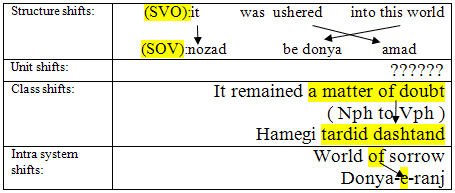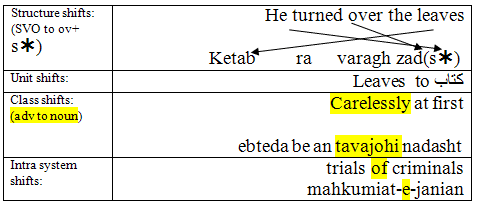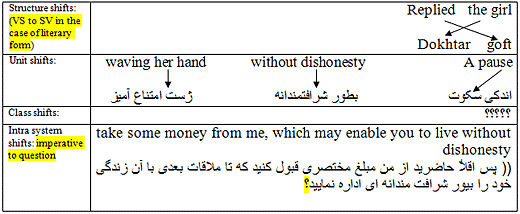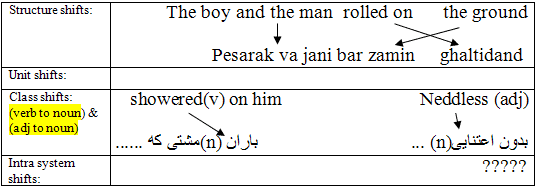Become a member of TranslationDirectory.com at just
8 EUR/month (paid per year)
 In the 1970s a literary approach to translation theory began to emerge,
partly as a response to the prescriptive linguistic theories that had
monopolized thinking for the previous two decades. Key elements of this
new literary approach are the writings of the Manipulation School; systems
theories; and Gideon Toury’s descriptive translation studies (DTS), which
tries to identify laws in translation, of which Itamar Even-Zohar’s Polysystem
Theory (PS) forms a vital part (Nam Fung Chang). At the Leuven Conference
in 1976, Even-Zohar presented a paper entitled “The Position of Translated
Literature in the Literary Polysystem” where he considers the position
of translated literature within the literary, cultural and historical
contexts of the target culture. He does not advocate the study of individual
translations, but rather views the body of translated works as a system
working within and reacting to a literary system, which, in turn, is working
within and reacting to the historical, social and cultural systems of
the particular target audience. Therefore, there is a system within a
system within a system i.e. the polysystem.
In the 1970s a literary approach to translation theory began to emerge,
partly as a response to the prescriptive linguistic theories that had
monopolized thinking for the previous two decades. Key elements of this
new literary approach are the writings of the Manipulation School; systems
theories; and Gideon Toury’s descriptive translation studies (DTS), which
tries to identify laws in translation, of which Itamar Even-Zohar’s Polysystem
Theory (PS) forms a vital part (Nam Fung Chang). At the Leuven Conference
in 1976, Even-Zohar presented a paper entitled “The Position of Translated
Literature in the Literary Polysystem” where he considers the position
of translated literature within the literary, cultural and historical
contexts of the target culture. He does not advocate the study of individual
translations, but rather views the body of translated works as a system
working within and reacting to a literary system, which, in turn, is working
within and reacting to the historical, social and cultural systems of
the particular target audience. Therefore, there is a system within a
system within a system i.e. the polysystem.
The notion of “system” does, perhaps, need some clarification at this
point. Literature viewed as a system can be traced back to Russian Formalist
thinking of the 1920s when Yury Tynjanov is credited with being the first
person to describe literature in these terms (Hermans, 1999, 104). Translated
literature itself is also considered to operate as a system in at least
two ways – firstly in the way that the TL chooses works for translation,
and secondly in the way translation methodology varies according to the
influence of other systems (Munday, 2001 109). Even-Zohar himself emphasizes
the fact that translated literature functions systemically: “I conceive
of translated literature not only as an integral system within any literary
polysystem but as an active system within it.” (1976, 200).
PS functions as a system on the level of a series of relationships between
apparent opposites. These are:
- canonized (high) and non-canonized (low) forms,
which opens the door for the consideration of detective and children’s
stories and their role in translation
- centre and periphery
- primary (innovative) and secondary (stagnant) models
- ST and TT
- Translated and non-translated texts (Hermans, 1999,
42).
The key idea of PS is that there is a continual repositioning of genres
in relation to each other, “a continual struggle for power between various
interest groups” (Hermans, 1999, 42), which helps give rise to the dynamic
nature of literature. If literature is to remain vibrant, it needs to
be in a constant state of fluctuation, with established, canonized forms
being constantly nudged and eventually replaced by newer, more innovative,
peripheral models. Therefore, translated literature does not occupy a
fixed position in a literary system because the system itself is in a
constant state of change, although Even-Zohar proposes that the secondary
position is really the normal position for translated literature (Munday,
2001, 110). However, even though change to the core comes from the peripheral,
new literary forms, when translated literature occupies this position,
it is generally perceived to be fairly conservative, working within the
confines of the target culture.
Even-Zohar does insist that there are occasions when translated literature forms
part of the nucleus, and it is then that the boundaries between translated
and original literature begin to merge, being virtually indistinguishable
from one another (Even-Zohar, 1976, 200). There are three possible
scenarios when this may occur:
1) When an emerging literature
from a relatively new culture adopts translations from more established
literatures in order to fill the gaps that exist within its own system,
due to it being unable to instantly create a wide range of text types
and genres. Translated literature introduces features and techniques
that did not previously exist, such as new poetic structures.
2) When a smaller nation
is dominated by the culture of a larger nation it may rely on imported
literature from the dominant culture in order to keep its literary system
dynamic, as well as being possibly the only source available for the
creation of new genres, for example Breton culture in Brittany may rely
heavily on literary styles from France in order o fill the gaps that
exist in its own literary system.
3) When there are turning
points in literary history, such as when established forms lose popularity
or when there is no existing model. This could conceivably be the role
that Harry Potter occupies in Chinese Mandarin.
There are also occasions when translated literature can occupy both
a central position and a peripheral position within a literary system.
This may occur when major social changes are taking place. Even-Zohar
exemplifies this with the role of translated literature in Israel in the
early 1900s when literature from Russian into Hebrew was more dominant
than translations from English, German or Polish (Munday, 2001, 110; Even-Zohar,
1976, 202).
Having briefly discussed the theoretical workings of the polysystem
approach, it now remains to be seen how it affects translation methodology.
Even-Zohar says that when a translated work occupies the central position,
it is generally strong in itself and doesn’t need to conform to target
culture conventions. The translator doesn’t try to adapt to TL models,
staying close to the original ST. If the position of translated literature
is weak, the reverse trend occurs. The translator tends to adopt more
features from the target culture, so the translation becomes target culture
dominant, often providing a less than satisfactory translation (Even-Zohar,
1976, 203-204; Munday, 2001, 110).
PS is important because it moves translation away from the traditional
ST-TT linguistic comparisons of shift and equivalence towards the viewing
of translation in a social, cultural and historical context. There is
also a change from the study of individual texts as a systemic approach
tries to uncover the universal laws and principles that govern translation.
It is also quite significant because it can be applied to other systems
other than literary systems, such as television programming and politics,
making the system itself universal.
PS has been widely criticized on a number of issues:
- Gentzler questions Even-Zohar’s objectivity, claims
that the universal laws are too abstract, criticizes the level of input
and the relevance of Russian Formalism, and states that little thought
has been given to limitations placed on translation and texts (Munday,
2001, 111).
- Berman condemns Even-Zohar’s proposition that translated
literature generally occupies a role of secondary importance in the
target culture because “it downplays their creative and formative aspect”
(Hermans, 1999, 154). Berman also thinks that translated literature
remains a separate entity within the target culture.
- Susan Bassnett thinks that comments describing
target literature as “young”, “weak”, “vacuum”, etc are highly subjective.
Subjectivity also dominates the definition as to what constitutes canonized
and non-canonized literature. She questions the abstract nature of the
theory which tends to neglect concrete examples while, at the same time,
wondering whether the theory has progressed much beyond the ideas of
Russian Formalism of the 1920s (Bassnett and Lefevere 1998: 127 in Hermans,
1999, 109).
- André Lefevere claims that Even-Zohar is
presumptuous in his claim that the systems he describes actually exist,
condemns the nature of the theory, and describes the terms “primary”
and “secondary” as “superfluous” (Hermans, 1999, 125).
- Philippe Codde believes that PS has become outdated
as other systemic theories are presented as alternatives (2003, 26).
- Theo Hermans argues against one of Even-Zohar’s
most fundamental principles by saying that the target culture may not
necessarily select the ST. He cites the example of the period of European
colonization when France and England were seen to be “dumping literary
items on a colonized population” (1999, 111). He also claims that the
series of binary opposites that constitute the polysystem theory doesn’t
take into account those factors that are not diametrically opposed.
While PS could be seen as offering an intellectual approach to translation,
I believe that it remains far too abstract in its presentation because
it does not provide concrete evidence, it does not venture into specifics,
or offer functioning examples. No mention is made of the concept of overt
and covert translations (this comes later), although Even-Zohar says that
it is difficult to differentiate translated literature from original when
placed in the central position.
Gideon Toury worked with Even-Zohar before moving on to develop his own general
theory of translation. In his “Descriptive Translation Studies – And Beyond”
(1995), he calls for a systematic approach to translation rather than
the study of individual cases. Firstly, he acknowledges that translation
occupies a place in the social and literary system of the target culture,
therefore recognizing polysystems. He proposes a three-phase TT-oriented
methodology:
1) Consider the text in
terms of the target culture to determine its significance and acceptability.
2) Compare segments of
the ST and TT to determine the linguistic relationship, by mapping
the TT onto the ST to find “coupled pairs”. (This point is controversial
because the choice of segments would be subjective).
3) Distinguish trends,
make generalizations, identify norms, and draw conclusions for future
decision-making.
This allows for the creation of a profile for the genre, period and
author. He argues for successive descriptions through time and concurrent
descriptions of the various recognized genres in society (Gaddis Rose,
1997, 5-10). From this framework, and from comments made by publishers,
reviewers and translators themselves, norms can be determined, which
show up regularities and trends.
Toury sees different kinds of norms in action during various stages of the translation
process. The first kind is the “initial norm” where the norm shifts
either towards the ST or the TT. If the shift is more towards the ST,
the TT is described as adequate. If the shift is towards the TT, the
ST is described as acceptable. This is an interesting concept because
Toury himself says that no translation is ever totally adequate or acceptable
(57). He describes other norms:
1) Preliminary norms,
which vary depending on translation policy, whether translation
occurs, choice of text, and directness of translation.
2) Operational norms,
which describe the presentation and linguistic nature of the TT.
This involves matricial norms that refer to the TT as a whole, such
as the addition of footnotes and passages, or the omission or relocation
of passages; and textual-linguistic norms that cover language and
stylistic features.
Through the identification of norms, Toury hopes to formulate translation
laws. The first law he proposes is “the law of growing standardization”(267-274),
which refers to the loss of source language variations and features
as the TT is made to conform to target language standards. The second
law is “the law of interference” where ST norms are translated as such
in the TT. This refers to such things as ST syntax being transferred
across to the TT, making it “read like a translation.” This relates
back to polysystems, because a target language is more likely to accept
source language syntax if the position of translated literature is in
the centre of the polysystem.
Toury’s work has been widely discussed:
- Gentzler (1993, 133-134) says that it has had
a major impact on translation studies because it has now moved away
from a one-on-one analysis, it considers literary tendencies in the
target culture, an original message can be conveyed in different ways,
and it considers both ST and TT in their own cultural systems. However,
he thinks that it does over generalize.
- Hermans thinks that it overlooks the status of
the ST in the source culture, and doesn’t believe it is possible to
find all of the variables and laws that apply to translation. He also
dislikes the terms “adequate” and “acceptable” because of other connotations,
preferring the terms “ST-oriented” and “TT-oriented”.
- Munday (1997) says that “the law of interference”
needs to consider the effects of patterning. He also says that there
is a need for clarity and an attempt to avoid ambiguity in the TT.
Although Toury claims that his norms are descriptive, Andrew Chesterman (1997)
states that the very concept of norms makes them prescriptive. Chesterman
proposes an alternative set of norms:
1) Product or expectancy
norms are what the reader would expect from a translated text in regards
to fluency and readability.
2) Professional norms
are those that “regulate the translation process” (1997, 67). There
are three types of professional norms – the accountability norm that
deals with professional standards of integrity, the communication
norm that aims to ensure communication between all the parties involved,
and the relation norm that deals with the ST/TT linguistic relationship.
In 1976, 1978 and 1980 The International Comparative Literature Association
held meetings and conferences around the world on the subject of translated
literature. The main outcome was a publication entitled “The Manipulation
of Literature: Studies in Literary Translation” edited by Theo Hermans.
It viewed literature as dynamic and complex, and called for more interaction
between theoretical models and practical case studies. The main issue
was how to proceed with the case studies. In 1985 José Lambert
and Hendrik van Gorp produced a paper called “On Describing Translations”
which proposes a scheme to compare ST and TT literary systems and the
relationships between the author, text and reader. There are four
sections to their scheme:
1) Preliminary data, which
includes information on the title page, in the preface, and any other
information about the translation.
2) The macro level, which
deals with the way the text is divided, the title, chapters and structure.
3) The micro level, which
investigates linguistic shifts.
4) Systemic
context involves a comparison of micro and macro levels, and text and
theory, leading to the identification of norms.
Lambert and van Gorp do not believe that it is possible to determine
all of the relationships involved in translation, but they do emphasize
the fact that all translations and translators are inextricably linked
to each other.
BIBLIOGAPHY
Chesterman, A. Memes of Translation. Philadelphia: John Benjamins,
1997.
Codde, Philippe. “Polysystem Theory Revisited: A New Comparative Introduction.”
pp 25-37
Poetics Today. Vol.24, No.1, Spring 2003.
Even-Zohar, Itamar. “The Position of Translated Literature within
the Literary Polysystem.” 1976.
In Venuti, Lawrence. The Translation Studies Reader. (2nd
Edition)
New York: Routledge, 2000. pp 199-204
Gaddis Rose, M. Translation and Literary Criticism. Manchester:
St Jerome, 1997.
Gentzler, E. Contemporary Translation Theories. London and
New York: Routledge, 1993.
Hermans, T. Translation in Systems. Descriptive and Systemic Approaches
Explained.
Manchester: St Jerome, 1999.
Munday, Jeremy. Introducing Translation Studies. Theories and Applications.
London: Routledge, 2001.
Nam Fung Chang. “The Cultural Turn of Itamar Even-Zohar’s Polysystems
Studies
Promises and Problems.” www.art.man.ac.uk
Toury, G. Descriptive Translation Studies – And Beyond. Philadelphia:
John Benjamins, 1995

 Among
many of the translation studies some whose focuses were on the text
alone concentrated on the formal changes rather than meaning e.g. catford’s
shifts, transpositions by Vinay and Darbelnet, etc. Translation as an
interlingual practice necessitates moving from the form of the SL to
the TL. In other words translation is a change of form (Larson 1984:
2 ) and this formal change takes place at different levels within a
text.
Among
many of the translation studies some whose focuses were on the text
alone concentrated on the formal changes rather than meaning e.g. catford’s
shifts, transpositions by Vinay and Darbelnet, etc. Translation as an
interlingual practice necessitates moving from the form of the SL to
the TL. In other words translation is a change of form (Larson 1984:
2 ) and this formal change takes place at different levels within a
text. 





